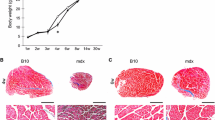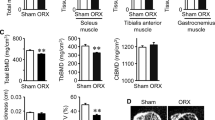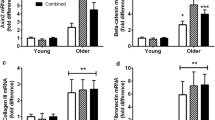Abstract
Mdx mouse, the animal model of Duchenne muscular dystrophy, lacks dystrophin and develops an X-linked recessive inflammatory myopathy characterized by degeneration of skeletal muscle fibers and connective tissue replacement. The present work aimed to assess whether gender dimorphism in mdx mice would influence skeletal muscle pathology at ages corresponding to main histological changes in the microenvironment of muscular tissue: myonecrosis, regeneration, and fibrosis. At the height of myonecrosis (6 weeks postnatal), skeletal muscles of male mdx mice showed increased sarcolemmal permeability, numerous inflammatory foci, and marked deposition of the extracellular matrix components (ECM) type I collagen and laminin. In contrast, age-matched mdx females showed mild ECM deposition, discrete myonecrosis, but increased numbers of regenerating fibers expressing the satellite cell marker NCAM. In contrast ovariectomized mdx females showed decreased numbers of regenerating fibers. Older (24 and 48 weeks postnatal) mdx females showed extensive fibrosis with increased sarcolemmal permeability and marked deposition of ECM components than corresponding males. These results suggest a role for female hormones in the control of myonecrosis probably by promoting regeneration of muscular tissue and mitigating inflammation especially at ages under the critical influence of sex hormones.





Similar content being viewed by others
References
Amelink GJ, Kamp HH, Bär PR (1988) Creatine kinase isoenzyme profiles after exercise in the rat: sex-linked differences in leakage of CK-MM. Pflugers Arch Eur J Physiol 412:417–421
Amelink GJ, Koot RW, Erich WB, Van Gijn J, Bar PR (1990) Sex-linked variation in creatine kinase release, and its dependence on oestradiol, can be demonstrated in an in-vitro rat skeletal muscle preparation. Acta Physiol Scand 138:115–124
Amemiya K, Semino-Mora C, Granger RP, Dalakas MC (2000) Downregulation of TGF-b1 mRNA and protein in the muscles of patients with inflammatory myopathies after treatment with high-dose intravenous immunoglobulin. Clin Immunol 94:99–104
Asakura A (2003) Stem cells in adult skeletal muscle. Trends Cardiovasc Med 13:123–128
Ashcroft GS, Dodsworth J, Boxtel EV, Tarnuzzer RW, Horan MA, Schultz GS, Ferguson MWJ (1997) Estrogen accelerates cutaneous wound healing associated with an increase in TGF-b1. Nat Med 3:1209–1215
Bar PR, Amelink GJ (1997) Protection against muscle damage exerted by oestrogen: hormonal or antioxidant action? Biochem Soc Trans 25:50–54
Bernasconi P, Torchiana E, Confalonieri P, Brugnoni R, Barresi R, Mora M, Cornelio F, Morandi L, Mantegazza R (1995) Expression of transforming growth factor-beta 1 in dystrophic patient muscles correlates with fibrosis. Pathogenetic role of a fibrogenic cytokine. J Clin Invest 96:1137–1144
Bulfield G, Siller WG, Wight PAL, Moore KJ (1984) X-chromosome-linked muscular dystrophy (mdx) in the mouse. Proc Natl Acad Sci U S A 81:1189–1992
Carlson CG (1998) The dystrophinopathies: an alternative to structural hypothesis. Neurobiol Dis 5:3–15
Charge SB, Rudnicki MA (2004) Cellular and molecular regulation of muscle regeneration. Physiol Rev 84:209–238
Cohen L, Morgan J (1976) Diethylstilbestrol effects on serum enzymes and isozymes in muscular dystrophy. Arch Neurol 33:480–484
Cohen L, Morgan J, Schulman S (1972) Diethylstilbestrol: observations on its use in Duchenne’s muscular dystrophy (DMD). Proc Soc Exp Biol Med 140:830–835
Crameri RM, Langberg H, Magnusson P, Jensen CH, Daa Schroder H, Olesen JL, Suetta C, Teisner B, Kjaer M (2004) Changes in satellite cells in human skeletal muscle after a single bout of high intensity exercise. J Physiol jphysiol.2004.061846
Ehmsen J, Poon E, Davies K (2002) The dystrophin-associated protein complex. J Cell Sci 115:2801–2803
Engvall E, Wewer UM (2003) The new frontier in muscular dystrophy research: booster genes. FASEB J 17:1579–1584
Ervasti JM, Ohlendieck K, Kahl SD, Gaver MG, Campbell KP (1990) Deficiency of a glycoprotein component of the dystrophin complex in dystrophic muscle. Nature 345:315–319
Foster RF, Thompson JM, Kaufman SJ (1987) A laminin substrate promotes myogenesis in rat skeletal muscle cultures: analysis of replication and development using anti-desmin monoclonal antibodies. Dev Biol 122:11–20
Galea E, Santizo R, Feinstein DL, Adamsom P, Greenwood J, Koenig HM, Pelligrino DA (2002) Estrogen inhibits NF kappa B-dependent inflammation in brain endothelium without interfering with I kappa B degradation. Neuroreport 13:1469–1472
Grounds MD (1991) Towards understanding skeletal muscle regeneration. Pathol Res Pract 187:1–22
Hamer PW, McGeachie JM, Davies MJ, Grounds MD (2002) Evans Blue dye as an in vivo marker of myofibre damage: optimising parameters for detecting initial myofibre membrane permeability. J Anat 200:69–79
Infante JP, Huszagh VA (1999) Mechanisms of resistance to pathogenesis in muscular dystrophies. Mol Cell Biochem 195:155–167
Johnson BJ, Halstead N, White ME, Hathaway MR, Dicostanzo A, Dayton WR (1998) Activation state of muscle stellate cells isolated from steers implanted with a combined trenbolone acetate and estradiol implant. J Anim Sci 76:2779–2786
Kahlert S, Grohe C, Karas RH, Lobbert K, Neyses L, Vetter H (1997) Effects of estrogen on skeletal myoblast growth. Biochem Biophys Res Commun 232:373–378
Komulainen J, Koskinen SOA, Kalliokoski R, Takala TES (1999) Gender differences in skeletal muscle fibre damage after eccentrically biased downhill running in rats. Acta Physiol Scand 165:57–63
Kurek JB, Nouri S, Kannourakis G, Murphy M, Austin L (1996) Leukemia inhibitory factor and interleukin-6 are produced by diseased and regenerating skeletal muscle. Muscle Nerve 19:1291–1301
Lagrota-Cândido J, Canella I, Savino W, Quirico-Santos T (1999) Expression of extracellular matrix ligands and receptors in the muscular tissue and draining lymph nodes of mdx dystrophic mice. Clin Immunol 93:143–151
Lagrota-Cândido J, Vasconcellos R, Cavalcanti M, Bozza M, Savino WQ, Quirico-Santos T (2002) Resolution of skeletal muscle inflammation in mdx dystrophic mouse is accompanied by increased immunoglobulin and interferon-g production. Int J Exp Pathol 83:121–132
Larionov AA, Vasyliev DA, Mason JI, Howie AF, Berstein LM, Miller WR (2003) Aromatase in skeletal muscle. J Steroid Biochem Mol Biol 84:485–492
Lefaucher JP, Sebille A (1996) Features of dystrophy in smooth and skeletal muscles of mdx mice. Muscle Nerve 19:793–794
Ling E, Robinson DS (2002) Transforming growth factor-beta1: its anti-inflammatory and pro-fibrotic effects. Clin Exp Allergy 32:175–178
Ma K, Mallidis C, Bhasin S, Mahabadi V, Artaza J, Gonzalez-Cadavid N, Arias J, Salehian B (2003) Glucocorticoid-induced skeletal muscle atrophy is associated with upregulation of myostatin gene expression. Am J Physiol Endocrinol Metab 285:E363–E371
McCormick KM, Burns KL, Piccone CM, Gosselin LE, Brazeau GA (2004) Effects of ovariectomy and estrogen on skeletal muscle function in growing rats. J Muscle Res Cell Motil 25:21–27
McGeachie JK, Grounds MD (1999) The timing between skeletal muscle myoblast replication and fusion into myotubes, and the stability of regenerated dystrophic myofibres: an autoradiographic study in mdx mice. J Anat 194:287–295
Mehler MF (2000) Brain dystrophin, neurogenetics and mental retardation. Brain Res Rev 32:277–307
Michele DE, Campbell KP (2003) Dystrophin-glycoprotein complex: post-translational processing and dystroglycan function. J Biol Chem 278:15457–15460
Mundegar RR, von Oertzen J, Zierz S (1995) Increased laminin A expression in regenerating myofibres in neuromuscular disorders. Muscle Nerve 18:992–999
Paroo Z, Dipchand ES, Noble EG (2002) Estrogen attenuates postexercise HSP70 expression in skeletal muscle. Am J Physiol Cell Physiol 282:C245–C251
Patton BL, Connoll AM, Martin PT, Cunningham JM, Mehta S, Pestronk A, Miner JH, Sanes JR (1999) Distribution of ten laminin chains in dystrophic and regenerating muscles. Neuromuscul Disord 9:423–433
Rosenkranz-Weiss P, Tomek RJ, Mathew J, Eghbali M (1994) Gender-specific differences in expression of mRNAs for functional and structural proteins in rat ventricular myocardium. J Mol Cell Cardiol 26:261–270
Santen RJ (2003) Inhibition of aromatase: insights from recent studies. Steroids 68:559–567
Schneider BS, Sannes HJ (2001) Consequences of skeletal muscle injury induced by unaccustomed exercise. Orthop Nurs 20:49–56
Schneider BSP, Correia LA, Cannon JG (1999) Sex differences in leukocyte invasion in injured murine skeletal muscle. Res Nurs Health 22:243–251
Schuler F, Sorokin LM (1995) Expression of laminin isoforms in mouse myogenic cells in vitro and in vivo. J Cell Sci 108:3795–3805
Seixas SIL, Wajsenzon IJ, Savino W, Quirico-Santos T (1994) Altered deposition of extracellular matrix components in the skeletal muscle and lymph node of the mdx dystrophic mouse. Braz J Med Biol Res 27:2229–2240
Snochowski M, Dahlberg E, Gustafsson JA (1980) Characterization and quantification of the androgen and glucocorticoid receptors in cytosol from rat skeletal muscle. Eur J Biochem 111:603–616
Straub V, Rafael JA, Chamberlain JS, Campbell KP (1997) Animal models for muscular dystrophy show different patterns of sarcolemmal disruption. J Cell Biol 139:375–385
Tiidus PM (2000) Estrogen and gender effects on muscle damage, inflammation, and oxidative stress. Can J Appl Physiol 25:274–287
Tiidus PM (2001) Oestrogen and sex influence on muscle damage and inflammation: evidence from animal models. Curr Opin Clin Nutr Metab Care 4:509–513
Tiidus PM, Holden D, Bombardier E, Zajchowski S, Enns D, Belcastro A (2001) Estrogen effect on post-exercise skeletal muscle neutrophil infiltration and calpain activity. Can J Physiol Pharmacol 79:400–406
Torrente Y, Tremblay JP, Pisati F, Belicchi M, Rossi B, Sironi M, Fortunato F, El Fahime M, D’Angelo MG, Caron NJ, Constantin G, Paulin D, Scarlato G, Bresolin N (2001) Intraarterial injection of muscle-derived CD34(+)Sca-1(+) stem cells restores dystrophin in mdx mice. J Cell Biol 152:335–348
Valentine BA, Cooper BJ, de Lahunta A, O’Quinn R, Blue JT (1988) Canine X-linked muscular dystrophy. An animal model of Duchenne muscular dystrophy: clinical studies. J Neurol Sci 88:69–81
Verthelyi D (2001) Sex hormones as immunomodulators in health and disease. Intern Immunopharmacol 1:983–993
Wehling M, Spencer MJ, Tidball JG (2001) A nitric oxide synthase transgene ameliorates muscular dystrophy in mdx mice. J Cell Biol 155:123–131
Wise PM, Dubal DB (2000) Estradiol protects against ischemic brain injury in middle-aged rats. Biol Reprod 63:982–985
Yamazaki M, Minota S, Sakurai H, Miyazono K, Yamada A, Kanazawa I, Kawai M (1994) Expression of transforming growth factor-beta 1 and its relation to endomysial fibrosis in progressive muscular dystrophy. Am J Pathol 144:221–226
Yao CC, Ziober BL, Sutherland AE, Mendrick DL, Kramer RH (1996) Laminins promote the locomotion of skeletal myoblasts via the alpha 7 integrin receptor. J Cell Sci 109:3139–3150
Zhai P, Eurell TE, Cotthaus R, Jeffery EH, Bahr JM, Gross DR (2000) Effect of estrogen on global myocardial ischemia-reperfusion injury in female rats. Am J Physiol Heart Circ Physiol 279:H2766–H2775
Acknowledgements
The authors are grateful to Nina M. Cortes and Bartira D. Oliveira for excellent technical assistance and to Dr. Edna Nanami Yamasaki for critical reading of the manuscript. This work received financial support from Program of Neuroimmunology (CAPES) and Faperj.
Author information
Authors and Affiliations
Corresponding author
Rights and permissions
About this article
Cite this article
Salimena, M.C., Lagrota-Candido, J. & Quírico-Santos, T. Gender dimorphism influences extracellular matrix expression and regeneration of muscular tissue in mdx dystrophic mice. Histochem Cell Biol 122, 435–444 (2000). https://doi.org/10.1007/s00418-004-0707-8
Accepted:
Published:
Issue Date:
DOI: https://doi.org/10.1007/s00418-004-0707-8




